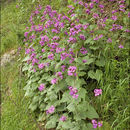en
names in breadcrumbs


Lunaria annua, commonly called honesty or annual honesty, is a species of flowering plant in the cabbage and mustard family Brassicaceae. It is native to southern Europe, and cultivated throughout the temperate world.

It is an annual or biennial growing to 90 cm (35 in) tall by 30 cm (12 in) broad, with large, coarse, pointed oval leaves with marked serrations. The leaves are hairy, the lower ones long-stalked, the upper ones stalkless.[2] In spring and summer it bears terminal racemes of white or violet flowers, followed by showy, green through light brown, translucent, disc-shaped[2] siliques (not true botanical seedpods), sometimes called moonpennies.[3] When a silique is ripe and dry, a valve on each of its sides readily falls off, and its seeds fall off a central membrane which has a silvery sheen, 3–8 cm (1–3 in) in diameter; the membrane can persist on a plant throughout a winter depending on the weather.[4] These siliques are much used in dry floral arrangements.
Lunaria annua is native to southern Europe from Spain to Romania, and has been introduced to many other parts of the world with temperate climates.[1]
The Latin name lunaria means 'moon-shaped' and refers to the shape and appearance of this species' siliques.[5] The common name "honesty" arose in the 16th century, and relates to the translucence of its silique membranes, which "truthfully" reveal their contents. Additional English names include money plant, moneywort, penny flower, silver dollar, and money-in-both-pockets,[6] Chinese money, or Chinese coins. These too reference the silique membranes, which have the appearance of silvery coins. For the same reason, in French it is known as monnaie du pape ("Pope's money"). In Denmark it is known as judaspenge and in Dutch-speaking countries as judaspenning (both meaning "coins of Judas"), an allusion to the story of Judas Iscariot and the thirty pieces of silver he was paid for betraying Christ.[7]
In the language of flowers, the plant represents honesty, money, and sincerity. In witchcraft, the honesty plant is considered protective, being thought to keep away monsters. The plant is also used in spells for prosperity, the flat pods (when ripe and silvery) resembling coins and therefore being seen as symbolising promises of wealth. In the earliest surviving recipe for a flying ointment (recorded by Bavarian physician Johannes Hartlieb circa 1440), Lunaria is included as the herbal ingredient corresponding astrologically to the moon and therefore to be picked on the lunar day of Monday.[8]
This plant is easy to grow from seed and tends to naturalize. It is usually grown as a biennial, being sown one year to flower the next. It is suitable for cultivation in a shady or dappled area, or in a wildflower garden, and the flowers and dried siliques are often seen in flower arrangements.[5] Numerous varieties and cultivars are available, of which the white-flowered L. annua var. albiflora[9] and the variegated white L. annua var. albiflora 'Alba Variegata'[10] have won the Royal Horticultural Society's Award of Garden Merit.[11]
Lunaria annua, commonly called honesty or annual honesty, is a species of flowering plant in the cabbage and mustard family Brassicaceae. It is native to southern Europe, and cultivated throughout the temperate world.
 Ripe pods (siliques), some with seeds visible, some with only the central membrane remaining
Ripe pods (siliques), some with seeds visible, some with only the central membrane remaining